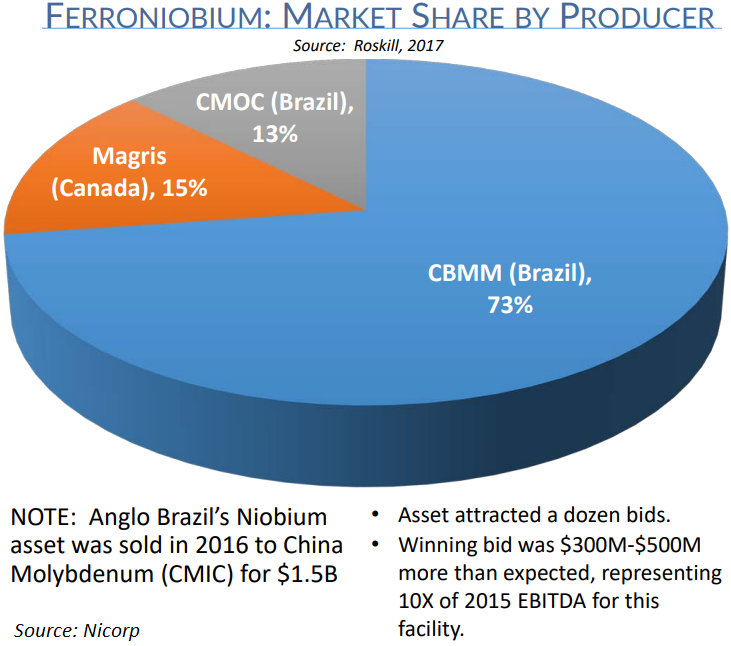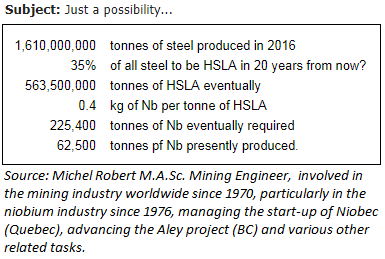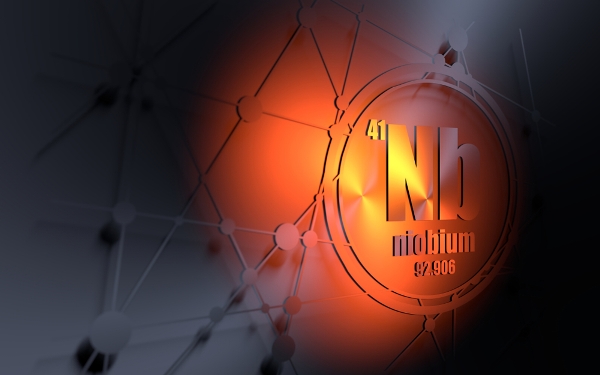Disseminated on behalf of Saville Resources Inc. and Zimtu Capital Corp.
Today, Saville Resources Inc. released astonishing assay results of a recent prospecting and sampling program from the Miranna Area of the Niobium Claim Group Property in Québec, Canada.
Extremely high-grade niobium was sampled in numerous well-mineralized boulders, which also contain high grades of tantalum (Ta2O5) and phosphorus (P2O5).
Phosphates are common in some of the world‘s largest and highest-grade niobium mines, such as Araxa and Catalao in Brazil. The Niobec Mine in Québec is a pyrochlore mine with no tantalum of any significance, as being the case with Araxa and Catalao (see here). These 3 mines alone are responsible for global niobium supply.
Thus, Saville‘s property is demonstrating great potential to host a niobium-rich pyrochlore deposit with significant by-product credits from phosphates and tantalum. This high-grade trio of mineral assemblage – niobium, phosphate and tantalum – makes Saville‘s property even more attractive to search for the source of those numerous, strikingly well-mineralized boulders.
The recent field work further supports the presence of a large and strongly mineralized boulder field with a source interpreted to be towards the south-southeast of Saville‘s property. The last ice age is thought to have dispersed the many boulders from its original source.
With a current market capitalization of $2.3 million CAD, Saville is looking to make a major discovery with an upcoming drill program as it has traced back the boulder train to a postulated source, which is coincident with a magnetic high anomaly.
Saville has signed an agreement to acquire up to 75% of the Niobium Claim Group Property and that agreement is now going through the TSXV approval process, whereafter a drill program is anticipated. See Saville’s news release and their grade disclosure here or on the following pages.
As outlined in the last Rockstone Report “Eager to Start the Treasure Hunt for Niobium in Quebec“, Saville‘s property has the right host rock and mineralogy for conventional metallurgical processing, that being carbonatite rock and pyrochlore mineralogy hosting the niobium. Pyrochlore is the dominant mineral source of niobium globally. Further, much of the pyrochlore is visible to the naked eye, thus indicating a relatively course grain size which is advantageous to metallurgical recovery.
According to today‘s press-release:
Saville Resources Releases 4.3% Nb2O5 Sampled on the Niobium Claim Group, Quebec
"Vancouver, B.C. - Saville Resources Inc. (TSXv: SRE, FSE: S0J) (the “Company” or “Saville”) is pleased to report the results of the recent prospecting and sampling completed throughout the Miranna Area, which forms part of its Niobium Claim Group (the “Property”) in northern Quebec. This work was conducted by Commerce Resources Corp. during their 2017 field program.
The Miranna Area is characterized by a strongly mineralized (Nb-Ta-Phosphate), glacially dispersed, boulder train with a source interpreted to be potentially on the Company’s Property. Prospecting work in the area continues to identify numerous, well-mineralized boulders, with the 2017 program returning a peak niobium sample of 4.3% Nb2O5, 240 ppm Ta2O5, and 13.4% P2O5, and a peak tantalum sample of 1.16% Nb2O5, 700 ppm Ta2O5, and 0.65% P2O5. A summary of results is presented in Table 1.
Table 1 – Select mineralized boulder sample results, collected on the Property from the Miranna Area in 2017
|
Sample ID |
Nb2O5 (%) |
Ta2O5 (ppm) |
P2O5 (%) |
|
119105 |
4.30 |
240 |
13.4 |
|
119079 |
2.75 |
130 |
7.6 |
|
119102 |
2.24 |
290 |
11.6 |
|
119097 |
0.69 |
350 |
8.8 |
|
119098 |
0.75 |
660 |
14.2 |
|
119095 |
1.18 |
590 |
13.1 |
|
119091 |
1.16 |
700 |
0.65 |
1. Ta2O5 and Nb2O5 are analyzed by XRF with a detection limit of 10 ppm
The recent field work further supports the presence of a large, strongly mineralized boulder field with a source towards the south-southeast. A distinct lull in mineralized boulders is coincident with the primary geophysical anomaly in the Miranna Area, of which approximately half is present on the Property. This anomaly, known as the Miranna Target, is interpreted to be a potential source of the boulder train. Further, the data suggests several overlapping boulder trains may be present, with one source potentially from the Southeast Area.
All samples were analyzed by Activation Laboratories Ltd. the Ancaster, ON facility for major oxide, rare earths, and trace elements by fusion ICP and ICP/MS, tantalum and niobium by XRF, and for fluorine by Fusion Specific Ion Electrode-ISE.
The Company intends to complete its maiden drill program on the Niobium Claim Group Property in the latter half of 2018. The program will aim to test the portion of the Miranna Target that is present on the Property, as well as further test the Northwest and Southeast areas, which are also considered highly prospective, with several well-mineralized drill intersections returned in prior years. Since the discovery of the Ashram Rare Earth Deposit, Commerce Resources Corp. elected to focus on that asset.
The Miranna, Southeast, and Northwest areas are all located within only a few kilometres of the Ashram Rare Earth Deposit, which suggests there could be significant potential for development synergies in the event a deposit of merit is defined by the Company on its Niobium Claim Group.
The Company is currently preparing an NI 43-101 Technical Report on the Niobium Claim Group Property, which consists of 21 contiguous claims within the Eldor Property held by Commerce Resources Corp. Saville recently signed an Earn-In Agreement (subject to TSX Venture Exchange approval) providing the Company with the exclusive right to earn up to a 75% interest in the Property (see news release dated January 11, 2018). The agreement is conditionally approved by the TSX Venture Exchange, pending receipt of an acceptable NI 43-101 Technical Report on the Property.
NI 43-101 Disclosure
Darren L. Smith, M.Sc., P.Geol., Dahrouge Geological Consulting Ltd., a Qualified Person as defined by National Instrument 43-101, supervised the preparation of the technical information in this news release.
About Saville Resources Inc.
The Company’s primary asset, subject to TSXV final approval, is the Niobium-Claim Group, recently acquired via Earn-In Agreement from Commerce Resources Corp. for up to a 75% interest. The Property consists of 21 contiguous mineral claims, encompassing an area of approximately 980 hectares, and is considered highly prospective for niobium and tantalum. The Property includes portions of the high-priority, and drill ready, Miranna Target where prior boulder sampling in the area has returned up to 5.9% Nb2O5 and up to 1,220 ppm Ta2O5, as well as the Northwest and Southeast areas where previous drilling returned wide intercepts of mineralization including; 46.88 m grading 0.46% Nb2O5 (EC08-008) and 19.54 m grading 0.85% Nb2O5 (EC08-033), respectively."

Full size / Boulder sampling on the Niobium Claim Group Property from Saville Resources Inc.
Most of the current exploration, development and operating niobium mines have resource grades between 0.3-2% Nb2O5, apart from the world‘s largest and highest grade niobium mine, Araxá in Brazil, with average grades of approximately 2.5% Nb2O5.

Full size / Source: "Critical Mineral Resources of the United States" (USGS, 2017)
Niobium Supply
In nature, niobium is closely associated with tantalum in igneous carbonate rocks, most commonly carbonatite. It is usually found in the interior parts of zoned alkaline igneous complexes, commonly associated with minerals containing thorium, titanium, uranium and rare earth elements. The oxide mineral pyrochlore is the most important mineral source of niobium. Between 2009 and 2012, 99 percent of mined niobium production globally occurred at just three mines: two in Brazil and one in Canada. Columbite is also a mineral source for niobium. It occurs mostly as an accessory mineral disseminated in granitic rocks or in pegmatites associated with granites. In most cases, economic mineral concentrations of columbite have been produced by weathering of pegmatites and the formation of residual or placer deposits. The United States obtains most of its supply of niobium in the form of ferroniobium. The only niobium recovered in the United States is from the recycling of niobium-bearing alloys. Niobium is recycled when niobium-bearing microalloyed or stainless steel and superalloy scrap is reused. The United States produces about 2 million metric tons per year of stainless steel that contains an estimated average of 0.014 percent niobium. (Source)
Brazil has the world‘s largest niobium reserves (98.5%), followed by Canada (1%) and Australia (0.5%). Brazilian niobium reserves total about 840 million t of Nb2O5, with an average grade of 0.73%. The only 2 Brazilian niobium mines are Araxá and Catalão with reserve grades of about 1.2% Nb2O5 (resources at 0.93% Nb2O5). Most of the current exploration, development, and operating mines for niobium have grades between 0.3% and 1.2% Nb2O5 (apart from Araxa averaging 2.5% Nb2O5). According to USGS in 2017: "Most of the identified carbonatites in the United States are currently known to have only low grades of niobium (Berger and others, 2009). An exception may be the Elk Creek carbonatite in Nebraska, which has inferred niobium resources of 102.6 million metric tons grading 0.638 percent Nb2 O5 (Daigle, 2012)."


For almost 50 years now, only 3 primary niobium mines are responsible for global supply:
Niobec (Québec, Canada)
• Deposit: Carbonatite
• Share in world supply: ~7%
• Average grade: 0.4-0.53% Nb2O5
• Owned by Magris Resources, a privately-held company (purchased from IAMGold for $500 million CAD in 2015)
Catalao (Brazil)
• Deposit: Carbonatite
• Share in world supply: ~7%
• Average grade: 0.9-1.3% Nb2O5
• Owned by China Molybdenum since April 2016 ($1.5 billion transaction with Anglo American)
Araxa (Brazil)
• Deposit: Carbonatite
• Share in world supply: ~85%
• Average grade: ~2.5% Nb2O5 (but with a 50% recovery)
• Owned by CBMM (Companhia Brasileira de Metalurgia e Mineração)
CBMM is a privately-held company, founded in 1955; since 1965 controlled by the Moreira Salles family, which became one of Brazil’s wealthiest families primarily thanks to its bet on niobium.Between 2006-2008, CBMM doubled the price of ferroniobium to address the strong demand growth that was, according to CBMM, not priced in correctly. As niobium prices remained flat over the last 9 years, CBMM may increase prices again to better reflect heightened demand.
Niobium Demand
Niobium can deliver powerful economic and environmental benefits in applications where it is used. For example, according to the World Steel Association, approximately $9 USD of niobium added to a mid-sized automobile can reduce its weight by 100 kg. That helps increase its fuel efficiency by 5%. And that‘s a huge return to consumers and our environment. As a commodity, niobium enjoys relatively stable pricing at attractive levels. It also is characterized by robust and diverse global markets, solid forecast growth rates, relatively limited substitution risk, and multiple applications across environmentally preferred technologies. Niobium has the largest magnetic penetration depth of any element. Niobium is used in making superconductive magnets owing to its superconductive properties. These magnets are in the form of niobium zirconium (Nb-Zr) wires. Hope exists that one day this Nb-Zr wire could direct large scale power generation.
Demand for niobium is expected to increase on the backs of national defense and the production of high-efficiency vehicles and super-alloys.Gobal steel production is expected to increase its usage of niobium (to make steel stronger and lighter) from currently about 10% to up to 20% over the next few years.
“Ferroniobium (FeNb) – key component of High Performance Steel used in mega-steel infrastructure projects, oil and gas pipelines, and most cars and trucks with a steel chassis. Ferroniobium is used in virtually all steel chassis vehicles today in order to reduce weight, increase fuel efficiency, reduce emissions, and increase safety margins. Niobium strengthens steel, allowing for lighter structures and vehicles, and makes steel more corrosion resistant. Niobium is vital to many markets, including aerospace, construction, transportation, oil & gas, superalloys. Ferroniobium is considered such a strategic and critical material by the U.S. Department of Defense that it stores FeNb in the National Defense Stockpile.“ (Source: Niocorp)

Applications & Benefits Full version
Full version
“$9 of Niobium added to a mid-sized automobile reduces its weight by 100kg, increasing fuel efficiency by 5%.“ (Source: World Steel Assosciation)

“The addition of 0.025% of Niobium to the steel in the Millau Viaduct reduced the weight of the steel and concrete by 60% in the overall project.“ (Source: CBMM)


Niobium: A Critical and Strategic Metal
The US Department of Defence has declared niobium as one of its top “strategic” metals as it is not mined domestically, is a matter of national security and is important to the nation’s economy. The US government maintains a stockpile of niobium at all times and according to the USGS, the DLA Strategic Materials plans to acquire more niobium to address the current shortfall. The US imports all of its niobium from Brazil (83%), Canada (12%) and others (5%). According to Reuters in December 2017:
"The United States needs to encourage domestic production of a handful of minerals critical for the technology and defense industries, and stem reliance on China, U.S. Interior Secretary Ryan Zinke said on Tuesday. Zinke made the remarks at the Interior Department as he unveiled a report by the U.S. Geological Survey (USGS), which detailed the extent to which the United States is dependent upon foreign competitors for its supply of certain minerals. The report identified 23 out of 88 minerals that are priorities for U.S. national defense and the economy because they are components in products ranging from batteries to military equipment. The report found that the United States was 100 percent net import reliant on 20 mineral commodities in 2016, including manganese, niobium, tantalum and others. In 1954, the U.S. was 100 percent import reliant for the supply of just eight nonfuel mineral commodities.
“We have the minerals here and likely we have enough to provide our needs and be a world trader in them, but we have to go forward and identify where they are at,” Zinke told reporters at an Interior Department briefing... Zinke said the report is likely to shape Interior Department policy-making in 2018, as the agency looks to carry out its “Energy Dominance” strategy, expanding mining and resource extraction on federal lands... It does not offer policy recommendations, but Zinke will rely on the findings as he prioritizes research into certain mineral deposit areas on federal land and plans policies to promote mining. “We do expect that to lead to policy changes. The USGS is not involved in policy, but I suspect you will see some policy changes,” said Larry Meinert, deputy associate director for energy and mineral resources at the USGS. The lead author of the report was Klaus Schultz, a geologist at the USGS."
The USGS study, Critical Mineral Resources of the United States, details 23 commodities deemed crucial due to their possibility of supply disruption with serious consequences.
See Niobium Chapter here. (Source: "Critical Attention: The U.S. embarks on a national strategy of greater self-reliance for critical minerals")
Consumption of niobium and tantalum is expected to increase in the coming years as industrial development in such countries as Brazil, China, and India continues, and the rapidly increasing global population demands more consumer goods, such as cars, cell phones, computers, and other high-tech products. Although the estimated reserves and resources of both niobium and tantalum are large and appear more than sufficient to meet global demand for the foreseeable future (British Geological Survey, 2011), the restricted concentration of niobium resources and production, and, to a lesser extent, those of tantalum, makes their stable supply vulnerable to potential influence and disruption. The United States currently lacks domestic self-sufficiency for both mineral commodities and is dependent on imports and recycling to meet its current and future needs. For the United States, the discovery of additional deposits of niobium and tantalum of better quality and quantity than those currently identified would be advantageous. New discoveries in the United States, particularly of niobium, may be facilitated by ongoing efforts to identify additional REE resources because alkaline and carbonatite complexes can host both deposit types. (Source: USGS, 2017)
Niobium Price

"Niobium -- named for a Greek goddess who became a symbol of the tragic mourning mother -- is used to produce stronger, lighter steel for industrial pipes and aircraft parts. It is mined in only three places on Earth, and the price of every kilogram is seven times higher than copper."(Source: "The commodity no one knows about but everybody wants to buy", Bloomberg)
In contrast to other strategic metals and REEs, niobium prices have only corrected marginally since the overall commodity slump started in 2011 and is rather explained with the USD strength. There are no official niobium prices as it is not traded on any metal exchange. Its price is determined solely by negotiation between buyer and seller.
In contrast to other strategic metals and REEs, niobium is not controlled by China; for instance: “China controls most of the world’s molybdenum and the country has taken advantage of this, flooding the market with supplies when international producers became a threat and then charging exorbitant prices for exports once the country has resumed its control of the metal’s supply. This has caused some massive fluctuations in the commodity’s price...“ (Source)
Company Details

Saville Resources Inc.
#1450 – 789 West Pender Street
Vancouver, BC, V6C 1H2 Canada
Phone: +1 604 681 1568
Email: mhodge@savilleres.com
www.savilleres.com
Shares Issued & Outstanding: 30,868,714
Canadian Symbol (TSX.V): SRE
Current Price: $0.075 CAD (04/11/2018)
Market Capitalization: $2.3 Million CAD
German Symbol / WKN (Frankfurt): S0J / A2DY3Z
Current Price: €0.043 EUR (04/11/2018)
Market Capitalization: €1.3 Million EUR
Previous Coverage
Report #3: “Eager to Start the Treasure Hunt for Niobium in Quebec“
Report #2: “Win-Win Situation to Develop One of the Most Attractive Niobium Prospects in North America“
Report #1: “Saville Resources: Getting Ready to Create Shareholder Value“
Disclaimer: Please read the full disclaimer within the full research report as a PDF (here) as fundamental risks and conflicts of interest exist.








